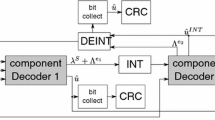Abstract
The immense diversity of the ways of building a turbo code (TC) and the firm mathematical unpredictability of their performance clearly leads (the user or designer) to simulate the operation of the TCs. The particularity of the TCs of using recursive algorithms in the decoding process, as well as the necessity of memorizing the data sequences in order to interlace them, imposes certain restrictions on the simulators. Also, having as target very small bit error/frame rates (BER/FER), the TC simulator is required a high processing speed and a fine resolution. If the necessary memory does not depend on the programming environment and does not, actually, raise any problems for the storage capacity of the present-day PCs, the speed and resolution are critical parameters. This paper compares turbo code simulators developed in Matlab, C and C#. The purpose of this comparison is that of revealing the advantages and disadvantages implied by every programming environment. The accuracy of the estimation of performances as well as the processing speed are compared.
Access this chapter
Tax calculation will be finalised at checkout
Purchases are for personal use only
Preview
Unable to display preview. Download preview PDF.
Similar content being viewed by others
References
Berrou, C., Vaton, S., Jezequel, M., Douillard, C.: Computing the Minimum Distance of Linear Codes by the Error Impulse Method. In: IEEE Global Telecommunications Conference, GLOBECOM 2002, Taipei, Taiwan, November 17-21, vol. 2, pp. 1017–1020 (2002)
Divsalar, D., Pollara, F.: On the Design of Turbo Codes, TDA Progress Report 42-123, November 15 (1995)
Hanzo, L., Liew, T.H., Yeap, B.L.: Turbo Coding, Turbo Equalisation and Space-Time Coding for Transmission over Fading Channels. John Wiley & Sons Ltd., England (2002)
Bahl, L.R., Cocke, J., Jelinek, F., Raviv, J.: Optimal Decoding of Linear Codes for Minimising Symbol Error Rate. IEEE Transactions on Information Theory 20, 284–287 (1974)
Box, G.E.P., Muller, M.E.: A Note on the Generation of Random Normal Deviates. The Annals of Mathematical Statistics 29(2), 610–611 (1958)
Moler, C.B.: Numerical Computing with MATLAB. SIAM (2004), http://www.mathworks.com/moler
Marsaglia, G., Tsang, W.W.: The ziggurat method for generating random variables. Journal of Statistical Software 5, 1–7 (2000)
Brillhart, J.: Derrick Henry Lehmer. Acta Arithmetica 62, 207–213 (1992)
ISO C standard, http://www.open-std.org/jtc1/sc22/wg14/www/docs/n1124.pdf
Marsaglia, G., Zaman, A.: A new class of random number generators. Annals of Applied Probability 3, 462–480 (1991)
Matsumoto, M., Nishimura, T.: Mersenne Twister: A 623-Dimensionally Equidistributed Uniform Pseudo-Random Number Generator. ACM Transactions on Modeling and Computer Simulation 8(1), 3–30 (1998)
Douillard, C., Berrou, C.: Turbo Codes With Rate-m/(m+1) Constituent Convolutional Codes. IEEE Transactions on Communications 53, 1630–1638 (2005)
Weiss, C., Bettstetter, C., Riedel, S., Costello, D.J.: Turbo decoding with tailbiting trellises. In: Proc. IEEE Int. Symp. Signals, Syst., Electron., Pisa, Italy, pp. 343–348 (October 1998)
Balta, H., Douillard, C., Kovaci, M.: The Minimum Likelihood APP Based Early Stopping Criterion for Multi-Binary Turbo Codes. In: Symposium of Electronics and Telecommunications – ETc 2006, Timisoara, Romania, pp. 199–203 (September 2006)
Author information
Authors and Affiliations
Corresponding author
Editor information
Editors and Affiliations
Rights and permissions
Copyright information
© 2012 Springer-Verlag GmbH Berlin Heidelberg
About this chapter
Cite this chapter
Balta, H., Isar, A., Isar, D., Balta, M. (2012). Simulating the Operation of Turbo Codes through the Monte Carlo Method, Comparison between MATLAB, C and C#. In: Sambath, S., Zhu, E. (eds) Frontiers in Computer Education. Advances in Intelligent and Soft Computing, vol 133. Springer, Berlin, Heidelberg. https://doi.org/10.1007/978-3-642-27552-4_146
Download citation
DOI: https://doi.org/10.1007/978-3-642-27552-4_146
Publisher Name: Springer, Berlin, Heidelberg
Print ISBN: 978-3-642-27551-7
Online ISBN: 978-3-642-27552-4
eBook Packages: EngineeringEngineering (R0)




